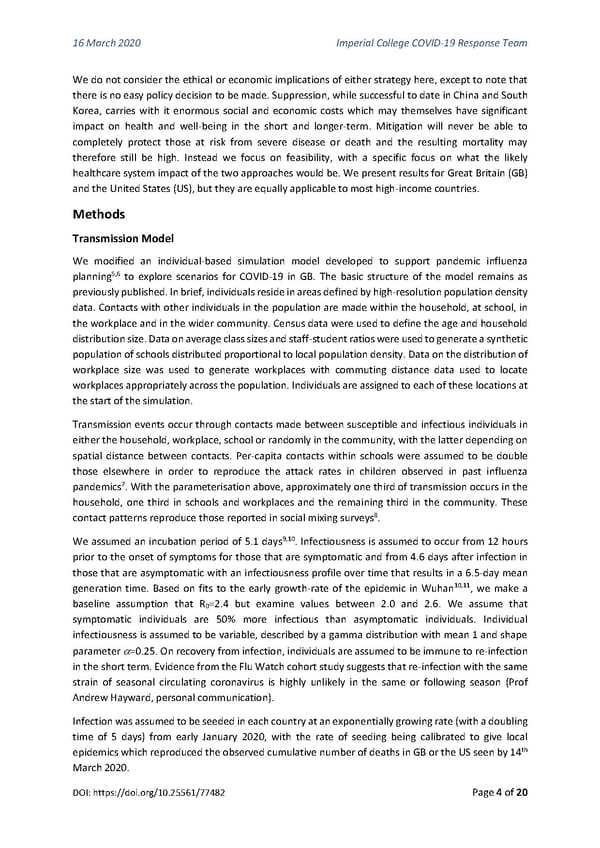16 March 2020 Imperial College COVID-19 Response Team We do not consider the ethical or economic implications of either strategy here, except to note that there is no easy policy decision to be made. Suppression, while successful to date in China and South Korea, carries with it enormous social and economic costs which may themselves have significant impact on health and well-being in the short and longer-term. Mitigation will never be able to completely protect those at risk from severe disease or death and the resulting mortality may therefore still be high. Instead we focus on feasibility, with a specific focus on what the likely healthcare system impact of the two approaches would be. We present results for Great Britain (GB) and the United States (US), but they are equally applicable to most high-income countries. Methods Transmission Model We modified an individual-based simulation model developed to support pandemic influenza 5,6 planning to explore scenarios for COVID-19 in GB. The basic structure of the model remains as previously published. In brief, individuals reside in areas defined by high-resolution population density data. Contacts with other individuals in the population are made within the household, at school, in the workplace and in the wider community. Census data were used to define the age and household distribution size. Data on average class sizes and staff-student ratios were used to generate a synthetic population of schools distributed proportional to local population density. Data on the distribution of workplace size was used to generate workplaces with commuting distance data used to locate workplaces appropriately across the population. Individuals are assigned to each of these locations at the start of the simulation. Transmission events occur through contacts made between susceptible and infectious individuals in either the household, workplace, school or randomly in the community, with the latter depending on spatial distance between contacts. Per-capita contacts within schools were assumed to be double those elsewhere in order to reproduce the attack rates in children observed in past influenza 7 pandemics . With the parameterisation above, approximately one third of transmission occurs in the household, one third in schools and workplaces and the remaining third in the community. These 8 contact patterns reproduce those reported in social mixing surveys . 9,10 We assumed an incubation period of 5.1 days . Infectiousness is assumed to occur from 12 hours prior to the onset of symptoms for those that are symptomatic and from 4.6 days after infection in those that are asymptomatic with an infectiousness profile over time that results in a 6.5-day mean 10,11 generation time. Based on fits to the early growth-rate of the epidemic in Wuhan , we make a baseline assumption that R =2.4 but examine values between 2.0 and 2.6. We assume that 0 symptomatic individuals are 50% more infectious than asymptomatic individuals. Individual infectiousness is assumed to be variable, described by a gamma distribution with mean 1 and shape parameter =0.25. On recovery from infection, individuals are assumed to be immune to re-infection in the short term. Evidence from the Flu Watch cohort study suggests that re-infection with the same strain of seasonal circulating coronavirus is highly unlikely in the same or following season (Prof Andrew Hayward, personal communication). Infection was assumed to be seeded in each country at an exponentially growing rate (with a doubling time of 5 days) from early January 2020, with the rate of seeding being calibrated to give local th epidemics which reproduced the observed cumulative number of deaths in GB or the US seen by 14 March 2020. DOI: https://doi.org/10.25561/77482 Page 4 of 20
 Non-Pharmaceutical Interventions to reduce COVID-19 mortality and healthcare demand Page 3 Page 5
Non-Pharmaceutical Interventions to reduce COVID-19 mortality and healthcare demand Page 3 Page 5